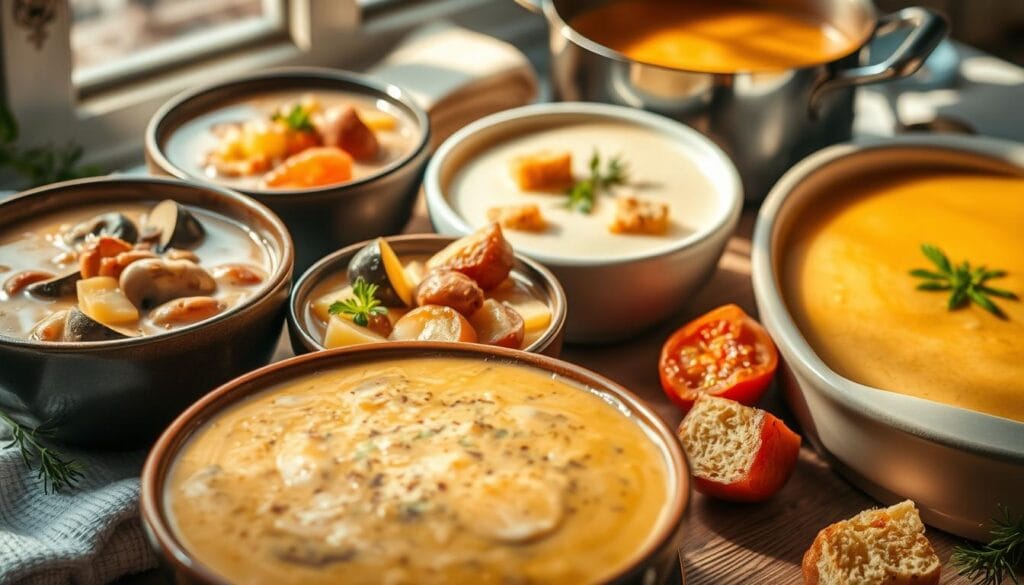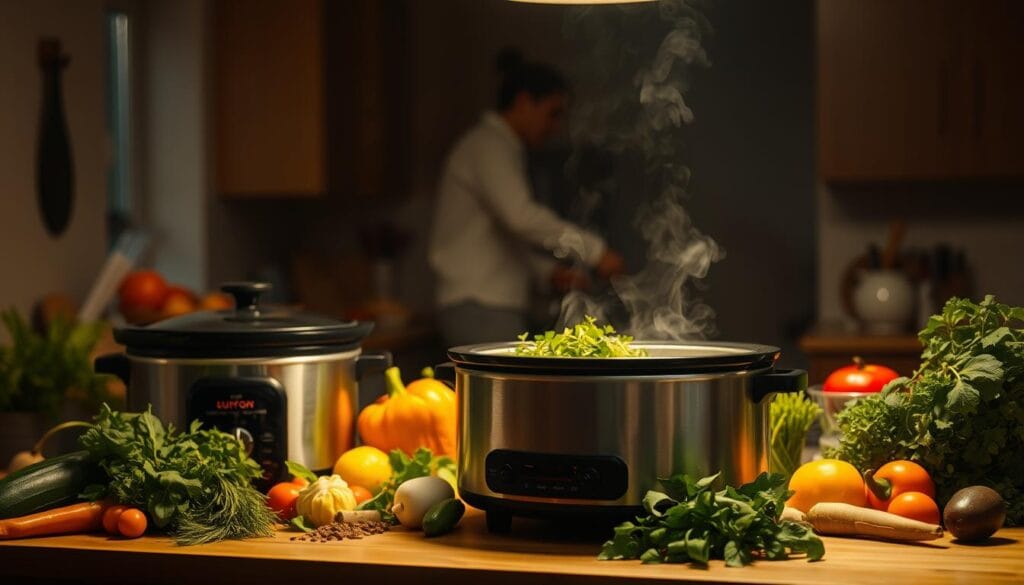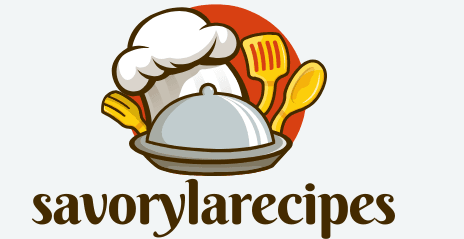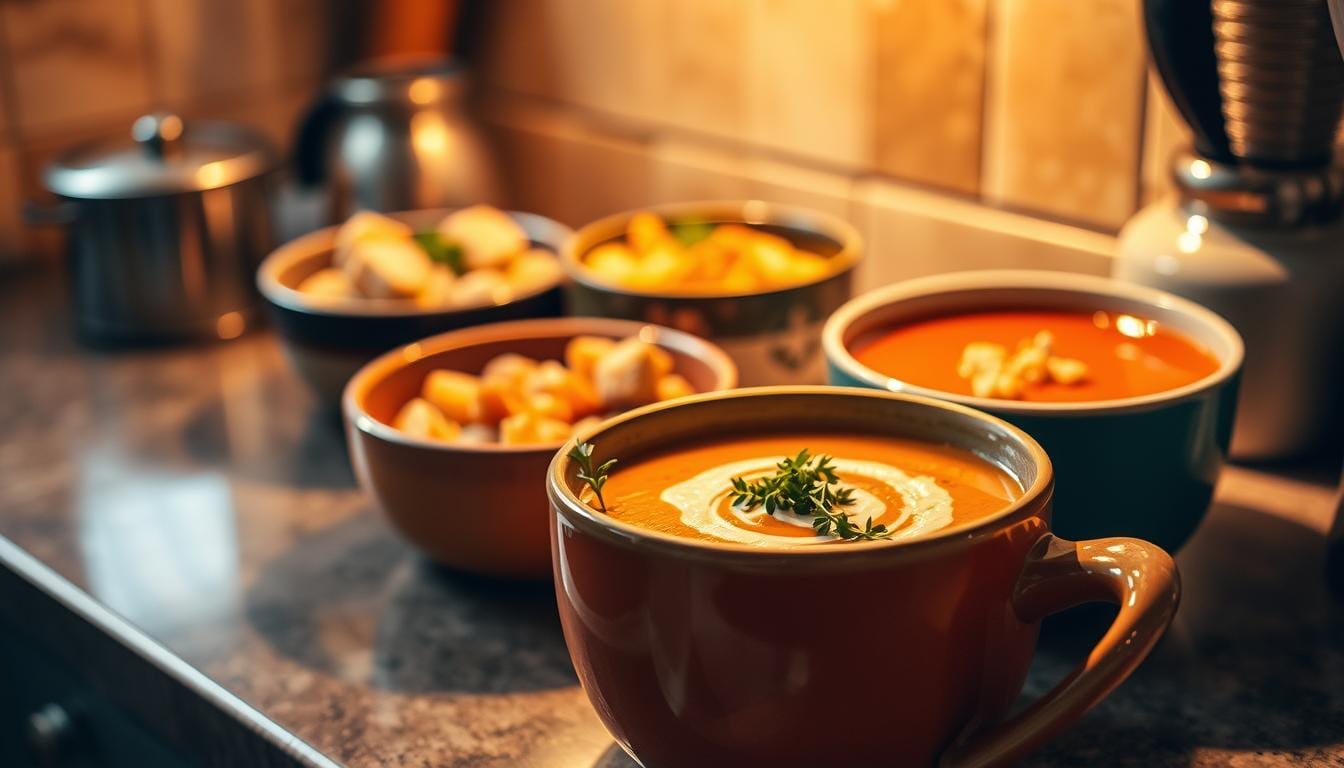Easy Kitchen Soups That Warm Your Heart and Soul
When it gets cold and the world outside looks gray, your kitchen has a special magic. Soup is more than just food; it’s a warm hug for your soul. It can make you feel better and give you the energy you need.
Think about turning simple things into a delicious, hot meal. This can change a bad day into a moment of happiness. With 28 amazing soup recipes, you’ll see how cooking can be both creative and healing.
Are you in the mood for a creamy Mushroom Soup that’s ready in 30 minutes? Or maybe a hearty Chicken Minestrone for a busy weeknight? These recipes will change how you cook at home. Each one is easy to make, full of flavor, and makes you feel good.
Table of Contents
Understanding the Soul-Warming Power of Homemade Soups
Soups have been a key part of human diet for thousands of years. Archaeologists found evidence of wild lentil use in Northern Africa and Asia over 13,000 years ago. This shows our long-standing bond with nourishing broths.
Making a warm bowl of soup is more than cooking. It’s creating a powerful emotional experience. This experience connects to our deepest sense of comfort and well-being.
The Psychology of Comfort Food
Soup does more than just feed us. It triggers strong psychological responses. The warmth, aroma, and flavor of a well-made stock can:
- Reduce stress and anxiety
- Provide emotional healing
- Create a sense of nostalgia
- Promote feelings of safety and care
Health Benefits of Hot Soups
Homemade soups are full of nutritional benefits. Lentils, for example, have 26% protein. This makes them a great choice for your diet.
| Nutrient | Benefits |
|---|---|
| Protein | Muscle repair and growth |
| Fiber | Digestive health |
| Minerals | Immune system support |
Traditional Healing Properties
Different cultures see soups as more than food. Traditional medicine views broths and stocks as healing. They support recovery, boost the immune system, and provide essential nutrients.
“A good soup stops the hunger, a great soup warms the soul” – Anonymous
Essential Kitchen Soups Equipment and Preparation Tips
Making delicious soups starts with the right tools. You need equipment that turns simple ingredients into warm, comforting meals. From big pots to sharp knives, each tool is important for your soup-making journey.
Must-Have Soup Preparation Equipment
- 16-quart stainless steel stock pot (available under $70)
- Cuisinart immersion blender ($46.99)
- High-quality chef’s knife
- Fine-mesh strainer
- Soup ladles
Good soup-making needs precision and patience. A strong stock pot cooks slowly, bringing out deep flavors. An immersion blender makes blending easy, right in the pot.
| Equipment | Price Range | Key Benefit |
|---|---|---|
| Le Creuset Dutch Oven | $250-$400 | Superior heat distribution |
| Soup Crocks | $20-$40 | Elegant serving |
| Ramekins | Under $20 | Individual portion control |
Invest in quality tools to make cooking easier and fun. Proper equipment turns cooking into an art. Special soup spoons help you enjoy more broth with each bite.
Great soup starts with great tools and passionate cooking!
Pro Preparation Tips
- Use fresh vegetables for maximum flavor
- Develop flavor bases with aromatic herbs
- Season gradually during cooking
- Use freezer-safe containers for batch storage
With practice, your soup-making will get better. Remember, 72% of people love homemade soups. With these tips, you’ll make meals that comfort and nourish.
Fundamental Soup Bases: Stocks and Broths
Creating the perfect soup starts with understanding stocks and broths. These liquid bases are key to making simple ingredients into delicious meals.
Stocks and broths might seem the same, but they’re not. Their main difference is how they’re made and what goes into them:
- Stock is made from bones and simmered for 4-6 hours
- Broth uses animal flesh and cooks for less than 2 hours
- Homemade stocks have more nutrients
Vegetable Stock Basics
When making vegetable stock, balance is key. The classic mix is:
- 50% onions
- 25% celery
- 25% carrots
Tip: Don’t season your stock. This lets you adjust the taste in your final soup.
Chicken and Beef Stock Foundations
For meat stocks, the rule is to use the right amount of veggies. About 2% of your bones should be veggies. This makes the flavor rich and balanced.
Seafood Stock Essentials
Seafood stocks need care. Use fresh shells and bones, and cook quickly to keep flavors light. This makes a perfect base for fancy soups and chowders.
Remember, a great soup starts with a great stock!
Classic Creamy Soups and Bisques
Explore the world of creamy soup recipes that turn simple ingredients into amazing dishes. Home cooks have found the secret to making velvety bisques and chowders. These soups warm the heart and excite the taste buds. With over 10,000 recipe reviews, creamy soups are a big hit.

Creamy soups are perfect for home chefs. You can make fancy lobster bisque or hearty potato chowder with just a few steps. The trick is to create smooth textures that make basic ingredients unforgettable.
- Lobster bisque: A luxurious seafood delicacy
- Chicken and corn chowder: Hearty winter favorite
- Butternut squash soup: Seasonal comfort in a bowl
- Broccoli-cheese soup: Classic crowd-pleaser
Recipe makers share some top tips for making creamy soups:
- Use heavy cream or coconut milk for richness
- Blend ingredients for smooth consistency
- Experiment with seasonal vegetables
- Add garnishes for extra flavor
| Soup Type | Key Ingredients | Preparation Time |
|---|---|---|
| Potato Leek Soup | Potatoes, Leeks, Cream | 45 minutes |
| Roasted Red Pepper Bisque | Red Peppers, Garlic, Onion | 30 minutes |
| Chicken Gnocchi Soup | Chicken, Gnocchi, Cream | 45 minutes |
Pro tip: The secret to a great soup is layering flavors and trying new ingredients. Feel free to change your favorite chowder or bisque to match your taste!
Hearty Vegetable and Legume Combinations
Explore nourishing soup recipes that highlight vegetables and legumes. These hearty mixes are not just tasty. They’re also packed with protein, fiber, and minerals.
Legumes, like lentils, are true nutrition powerhouses. Did you know dried lentils have 26% protein? They’re not just tasty. They’re also full of potassium, magnesium, and folate.
Mediterranean-Style Soups
Mediterranean soups are full of vibrant flavors and healthy ingredients. These stews often include:
- Fresh vegetables
- Olive oil
- Herbs like oregano and thyme
- Beans and lentils
Asian-Inspired Vegetable Soups
Asian soups offer amazing vegetable variations. They mix complex flavors with great nutrition. From miso to hot and sour soup, these recipes turn simple ingredients into unforgettable dishes.
Lentil and Bean Variations
| Legume Type | Protein Content | Cooking Time |
|---|---|---|
| Red Lentils | 9g per 1/2 cup | 15-20 minutes |
| Chickpeas | 7g per 1/2 cup | 30-40 minutes |
| White Beans | 8g per 1/2 cup | 45-60 minutes |
Try different legumes to make versatile, protein-rich soups. They fit various diets and tastes.
Quick and Easy 30-Minute Soup Recipes
Busy home cooks, rejoice! Soup recipes don’t have to take a lot of time. With the right techniques, you can make tasty meals in just 30 minutes. Our speedy soup recipes will make your weeknight dinners amazing.
Let’s explore some soup techniques for quick meals:
- Use pre-chopped vegetables from the grocery store
- Leverage rotisserie chicken for instant protein
- Keep pantry staples like canned beans and broth on hand
- Invest in a good quality Dutch oven for faster cooking
Our star recipe, the 30-Minute Nacho Chicken Soup, is packed with flavor. It’s a crowd-pleaser that’s quick to make. It has about 485 calories per serving and 28 grams of protein, making it both tasty and nutritious.
“Great soup doesn’t require hours of preparation – just smart techniques and fresh ingredients!”
Here are some fast soup recipes to try:
- Classic Chicken Noodle Soup (25 minutes)
- Creamy Tomato Basil Soup (20 minutes)
- Spicy Black Bean Soup (30 minutes)
- Veggie Minestrone (25 minutes)
Pro tip: Most of these soups can be stored in the fridge for 5-7 days or frozen for up to 6 months. Batch cooking is easy with these quick and flexible recipes!
International Soup Inspirations
Start a journey around the world with the most delicious soup recipes. Each place has its own flavors and traditions. These turn simple ingredients into warm, comforting dishes. From spicy chowders to hearty stews, these soups share stories of culture, heritage, and cooking passed down through generations.
Thai and Vietnamese Soups
Southeast Asian soups are full of bright flavors and fragrant ingredients. Tom Kha Gai, a Thai coconut soup, is a masterpiece. It mixes coconut milk, lemongrass, and red curry paste. You can add shrimp for a seafood twist.
- Thai coconut soup combines rich flavors of coconut milk and spices
- Vietnamese pho represents a delicate balance of herbs and broth
- Lemongrass and ginger provide distinctive Southeast Asian taste profiles
European Classics
European soups have a rich history, with each country offering its own special recipe. French onion soup is a classic, while Italian minestrone is packed with vegetables. These soups show the innovation and use of local ingredients over centuries.
- French onion soup features caramelized onions and rich beef broth
- Italian minestrone combines multiple vegetables and beans
- European stew recipes often incorporate local meats and seasonal produce
Latin American Favorites
Latin American soups are known for their bold flavors and hearty ingredients. Tortilla soup from Mexico and Brazilian black bean stew are favorites. These dishes show how local ingredients make simple soups into amazing meals.
- Mexican tortilla soup offers spicy, tangy flavor combinations
- Brazilian black bean stew provides protein-rich nutrition
- Latin American chowders frequently include local seafood and spices
Slow Cooker and One-Pot Soup Solutions

Cooking soups is now easier than ever with slow cookers and one-pot methods. These kitchen tools make soup-making simple and delicious. They turn cooking into a breeze, whether you want a hearty stew or a comforting soup.
Slow cookers are perfect for soup lovers. They let you make tasty recipes with little effort. Our collection has everything from creamy potato soups to zesty bean stews.
- Prepare soups with minimal hands-on time
- Develop rich, deep flavors through slow cooking
- Reduce kitchen cleanup with one-pot solutions
Here are some nutrition-packed slow cooker soup recommendations:
| Recipe | Calories | Protein | Cooking Time |
|---|---|---|---|
| Loaded Potato Soup | 447 | 14g | 6-8 hours |
| Southwestern Chicken Stew | 312 | 24g | 4-6 hours |
| Zippy Bean Stew | 208 | 11g | 3-5 hours |
Pro tip: Most slow cooker soup recipes can be made ahead and stored in the fridge overnight. Just start your cooker in the morning for a ready meal when you get home.
Slow cooking isn’t just about convenience—it’s about transforming simple ingredients into extraordinary meals.
Conclusion
Your journey through soup recipes has been more than just cooking. Kitchen soups are a timeless tradition of nourishment and comfort. They connect us to our cultural heritage and personal memories.
Cooking soups is about understanding flavor, texture, and personal expression. Both professional chefs and home cooks love making dishes that warm the soul. Whether it’s a hearty vegetable soup or a delicate bisque, the key is to approach each recipe with curiosity and love.
The best soup recipes come from intuition and personal taste. Professional chefs emphasize layering flavors and using fresh herbs. Your kitchen is a canvas, and soup is your medium for creativity. Embrace the process, experiment, and enjoy the warmth and connection a well-made soup brings.
Keep making soups, trusting your instincts, and learning from each attempt. Your kitchen soups are more than food. They’re an expression of care, tradition, and love.
FAQ
What equipment do I need to start making homemade soups?
How long can I store homemade soup?
Can I make soups if I have dietary restrictions?
What’s the difference between stock and broth?
How can I make my soups more flavorful?
Are soups nutritionally beneficial?
How can I make a quick soup on a busy weeknight?
Can I freeze homemade soup?
Source Links
- 28 Easy Soup Recipes That Will Warm Your Soul – https://airfryermom.com/28-easy-soup-recipes-that-will-warm-your-soul/
- 30 Healthy Winter Soups That’ll Fill You Right Up – https://www.tasteofhome.com/collection/healthy-winter-soups/?srsltid=AfmBOop0PV_CgK3UQBV9XySE7CzoqRdPnnnTN9vwyoXjqAfFGribu-kn
- Ree’s Creamy Potato Soup Is Like a Warm Hug – https://www.thepioneerwoman.com/food-cooking/recipes/a12045/perfect-potato-soup/
- A Healing Soup To Warm Your Soul – https://www.thesacredscience.com/a-healing-soup-to-warm-your-soul/
- Grandma Chicken Soup Recipe: 4 Steps to Make The Best Taste Just Like Childhood – https://blendrecipeshub.com/grandma-chicken-soup/
- 17 Soul-Warming Vegan Soup Recipes – https://www.tasteofhome.com/collection/vegan-soup-recipes/?srsltid=AfmBOoqZoH4M9w0B0cunVZgPXRNrBr99bp45zB9SHCCOzQ_EWT9hae0t
- Prepare for soup season with these 9 kitchen finds – https://www.foxnews.com/deals/soup-season-kitchen-finds
- Soup Making Tools – https://www.surlatable.com/o?c=soup-making-tools&srsltid=AfmBOoqxJB1Tk_rREa5PtOB9S8G3z6DkkPcQ353j9uwHXUdVoLhmzgO2
- Kitchen Essentials To Make You Soup-Ready – https://largefamilyfrugalliving.com/kitchen-essentials-to-make-you-soup-ready/
- The Difference Between Broth and Stock and When to Use Each – https://www.marthastewart.com/broth-vs-stock-7964091
- Stocks, Broths & Consommés – https://ajeanneinthekitchen.com/2024/08/21/stocks-broths-consommes/
- 21 Creamy Soup Recipes To Keep You Cozy When It’s Cold Outside – https://www.allrecipes.com/creamy-soup-recipes-8777211
- Whip Up These Creamy, Dreamy Soups That Are Velvety Smooth – https://www.thepioneerwoman.com/food-cooking/meals-menus/g33637382/creamy-soup-recipes/
- Vegetable Soup – Love and Lemons – https://www.loveandlemons.com/vegetable-soup/
- Easy Vegetable Soup – https://www.inspiredtaste.net/37646/vegetable-soup-recipe/
- 30 Vegetable Soups for Every Season – https://www.tasteofhome.com/collection/recipes-for-vegetable-soup/?srsltid=AfmBOoqEGAY_bkfn8KSuVdqa2bu4xtRQyf67CV0dbmvfw3uLBbqUdGE3
- 12 Soup Recipes That Are On The Table In 30 Minutes Or Less – https://www.southernliving.com/30-minuite-soup-recipes-7093486?srsltid=AfmBOooT1K5r8SzNmqvPN9l-EIUWSt2qS4ztbZoZVlGrmCxgz1PCW3lt
- Easy 30-Minute Homemade Chicken Tortilla Soup – https://www.averiecooks.com/easy-30-minute-homemade-chicken-tortilla-soup/
- 34 Soup Recipes That Are Ready to Eat in 30 Minutes – https://www.tasteofhome.com/collection/30-soup-recipes-ready-in-30-minutes/?srsltid=AfmBOoouhMDK4tn8-xJZxrpNVUK7g9ztIJ8Sje2J3CtUUhSWEquNeYf6
- Best Seafood Soup Recipes with History and Chef Tips – https://globalseafoods.com/blogs/recipes/5-delicious-seafood-soup-recipes-that-will-warm-your-soul?srsltid=AfmBOoqFi8kNoPfw-I5F4kzBfvGnBAH0UgyeMCi_ss3SSqjNxHpoykI-
- 5 Soup Recipes to Warm You Up This Winter | Homes To Love – https://www.homestolove.com.au/entertaining/soup-recipes/
- 95 International Recipes to Make When You’re Craving Global Cuisine – https://www.tasteofhome.com/collection/travel-around-the-world-in-80-meals/?srsltid=AfmBOoqRwV0Qg_CW0acCM6nfpK72ExExMZ3Td-C0Vrr8vtoLwf21hIm7
- Slow Cooker Soups with Pasta – https://www.slowcookerfromscratch.com/the-best-slow-cooker-soups-with-pasta/
- 75 One-Pot Meals That Only Require a Slow Cooker – https://www.tasteofhome.com/collection/slow-cooker-one-pot-meals/?srsltid=AfmBOorYUwOOg-8j-6ClE6fB33Ek5VM2tQz37yh9XZzFZdafVZW_mIZ3
- Chefs Share The Tricks And Tips They Use To Create A Restaurant-Quality Bowl Of Soup – Mashed – https://www.mashed.com/1639157/chef-tricks-tips-restaurant-quality-soup/
- Is Soup a Food or Drink? Join the Great Debate. – https://www.campbellsoup.co.uk/blog/is-soup-food-or-drink/
Have You Given Our Recipe a Try?
There are no reviews yet. Be the first one to write one.

